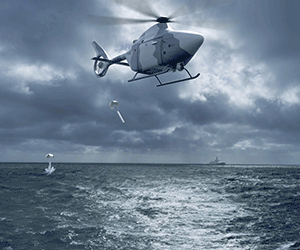A&D supply chains at tipping point

Image copyright Shutterstock
The industries most directly and immediately affected by COVID- 19 are aviation and aerospace, as borders were shut and lockdowns across the world ensued. The trade body IATA predicted a 48 per cent fall in traffic this year and if it proves correct, at least seven years of airline passenger traffic growth would be wiped out in 2020, according to consultancy Cirium. Airlines are looking to cancel or postpone aircraft orders on a massive scale.
What is the affect of this on aerospace & defence manufacturers such as Boeing, Airbus, BAE, Lockheed to name but a few, whether we are speaking of commercial or defence products?
The answer is that these companies are struggling with the uncertainty of future demand. In fact, Airbus chief executive Guillaume Faury has told the 133,000 employees of the company that Airbus has lost a third of its business in a matter of weeks. He stated “We’re bleeding cash at an unprecedented speed, which may threaten the very existence of our company”. Boeing has announced that it plans to cut its workforce by 10 per cent, as the coronavirus pandemic throttles global demand for jets and forces the manufacturer to lower production rates for nearly its entire portfolio of commercial planes.
If that is the situation for the aerospace & defence manufacturers themselves, what can be said of the supply chains?
As we know, supply chains are key to the ability of aerospace & defence organisations to function efficiently and effectively. These chains are incredibly complex and are made up of several tiers of different types of suppliers. Included are scores of original equipment manufacturers (OEMs), repair and overhaul providers (R&O), small parts suppliers, and maintenance support through to the customers, whether commercial or military.
To make this even more complex, over the past few decades both the supplier and customer base have become global in nature. Supply chains have adopted digital technologies, are vertically integrated and operate on a just-in-time basis. This makes management of supply chains difficult in the best of times but what happens when the global system of trade fractures as it has now due to COVID-19?
COVID-19 hit suddenly, without much warning, and companies and governments alike were ill-prepared for its overwhelming impact on infrastructures. Almost overnight supply lines were impacted as first Asia, then Europe and the Americas were impacted by the virus. Countries reacted by closing borders and going into lockdown. Nothing functioned as it ordinarily should. Given the extent to which aerospace & defence companies had integrated global supply chains, the results are devastating.
Over the past decade there has been an emphasis on risk sharing partnerships in supply chain contracting. The mantra was collaborative agreements based on risk and revenue sharing arrangements. This covered development, production, manufacturing and after-market activities. This means that the pain of what is now happening due to COVID -19 has also been spread. In particular, suppliers in developing countries are feeling the pain and their employees severely affected. What is interesting is that supply chain management over the past few decades has been focused on cost reduction and outsourcing. As security of supply is becoming the focus due to COVID-19 supply shortages, is that all about to change?
The added challenge for the aerospace and defence industries is that their supply chains are often specialised and require companies to be pre-qualified. This qualification process takes a period of time to achieve and can be costly. Often customer requirements and specifications inhibit the use of certain suppliers, further narrowing the supply chain. National security requirements might also limit choice of suppliers and where offset requirements dictate the use of particular suppliers, the manufacturer is further restricted. It is therefore not a matter of simply moving on to someone else.
So what should companies do now to deal with their supply chain pain, recognising that when they emerge from this they will want their supply chain not only to survive, but to be capable of returning to normal capacity rapidly if demand requires it?
The first and immediate impact will be reviewing legal positions to have a view of what obligations exist. Here legal principles such as force majeure, frustration, change in law, material adverse effect and impossibility all play a role. The governing law of the contract will be critical in formulating this analysis. To assist, Bird and Bird has developed a handy 10 step guide reviewing key contract clauses under English, French, German, Italian and Polish law.
Going forward what can this crisis teach us about building more resilient supply chains?
A supply chain’s ability to respond to and recover from disasters such as COVID-19 is determined not only by the type of event, but also by the nature of the supply chain system put in place. Traditionally, managing risk was an exercise in identifying risks that may affect a company and its supply chain and then managing those risks in a piecemeal manner. The focus was on short-term recovery. The nature of the system did not need to be taken into account, as it was largely operating in the same manner over a long period of time, and the parts were not interdependent.
Today, given increasingly complex and interconnected supply chains, the traditional approach is no longer effective. The focus now has moved from managing a risk to managing a system. This means risk can no longer be fully understood in terms of a specific event such as an earthquake, fire or even a pandemic, but in terms of an overarching system – what some call “systemic risk”. This means moving risk management from an event approach to a resilience approach. The first looks from the outside in (how the risk will impact on the system – event-centric), whereas the latter looks from the inside out (how the system will respond to the risk – system-centric). Going forward from this Crisis, we need to concentrate on a system-centric supply management approach. Supply chains have to become more resilient.
Resilience looks at how a system deals with change; it is system-centric rather than event- centric. A whole-of-system approach can be understood in terms of the types of risk that might enter the system (an input view of risk) versus the types of disruptions that might occur (an outcome view of risk).
An input view of risk does not categorise risk in terms of high or low probability or magnitude, the way an outcome view of risk would. It tries to understand possible events in terms of knowledge about the risks. An updated means of categorising risk has been described as: “completely novel (such as space weather), modern (such as climate change or cybercrime), infrequent (such as pandemics), spasmodic (such as earthquakes and volcanoes) and traditional (such as business and infrastructural risks).”
The understanding of a category of risk contributes to helping businesses respond to it when it happens. It is relatively easy to build resilience into a system in order to prepare for spasmodic and traditional disruptive events; however, the reverse is also true. Building resilience into a system that has little or no knowledge about novel, modern or infrequent disruptive events is difficult. The only way to build in such resilience is to work at understanding more about these types of disruptive events and build in a certain degree of redundancy based on the unique characteristics of such events.
A whole-of-system approach to managing risk looks at large numbers of commonalities between different types of risk. For example, you can compare earthquakes to a pandemic, flood or another event. The initial responses will share certain commonalities: the need for short-term housing/hospitals; the need for hot food, water and medicine; the need for infrastructure to work, such as water systems, power and technology; the need to communicate clearly in a timely manner; the need to make alternative arrangements for transport.
Resilience can relatively easily be built into a supply chain system to manage these short-term local disasters. However, as supply chains becomes more interconnected and complex, dependencies can lie unseen and untested, only to become apparent when a key link in the supply chain becomes broken and alternatives have not been identified. This is when supply chain resilience becomes critical. COVID-19 is at the moment demonstrating this fact. It is a global pandemic with all that this implies for workforces, manufacturing capability, supply of raw materials and parts, disruption of transport systems and closed borders.
It is however, rapidly becoming a financial crisis as well, as employees are furloughed, demand drops dramatically, revenue dries up, banks refuse or are unable to lend and governments begin to incur significant debts. This puts immense strain on maintaining supply chains and allowing them to recover once the crisis is over.
A possible way to identify key dependencies is to follow critical flows in the system and work out how they might be disrupted and how those disruptions might best be reduced. This concept allows for identification of multiple risks and shocks. Here, the opportunity is to follow the flow of goods and services to assess the supply chain risks to the entire system. Resilience can be added in to deal with several independent or connected events such as a pandemic and a hurricane occurring simultaneously and adding in global risks such as a financial crisis.
A resilient supply chain is fundamental to delivering core products and services over long periods in times of stress. A resilient system is much more than natural disaster management or epidemic management. It requires an understanding of where the overall system is weakened by events and how it might be strengthened to cope with them.
The World Economic Forum, in a 6th April 2020 publication looking at supply chain disruption due to COVID-19, makes several excellent recommendations to make supply chains more resilient. We have added below several additional tips to help make supply chains more resilient after COVID-19. They include:
1. Move away from paper to digitisation
The need for a physical presence to deal with physical assets has proven to be a major issue when personnel are required to come to an office. Digitizing limits the points of failure in a supply chain and allows operations to continue even when there is a lockdown.
2. Dealing with data privacy
Suppliers are reluctant to provide information to customers, because they fear losing commercial advantage if confidential data about operations, pricing and sourcing is shared. In a crisis situation, this is however disruptive as it does not permit flexibility and continuity of supply.
What is recommended is a blockchain with private or public permissions, which allows suppliers to audit data-sharing permissions directly on their blockchain node. This allows data to be securely distributed to others in the blockchain network.
3. Provide for financial flexibility
Blockchain can also be used to help with financing needs and institute supply chain finance programmes. This allows data on performance and risk at all tiers to be shared securely. This permits payment commitments on the blockchain to replace Letters of Credit, pay suppliers automatically, insulate from supplier bankruptcy. Suppliers are paid sooner and can replace more costly supply chain finance arrangements.
4. Build collaborative dispute mechanisms into supply chain contracts
COVID-19 has shown how quickly legal obligations are impacted and the need to be flexible and restructure them through collaboration, rather than confrontation is crucial. Allowing for structured negotiations with a neutral, or mediated settlements, rather than immediately looking to litigation to resolve disruption to legal obligations becomes a necessary tool for survival of supply chains.
5. Build greater redundancy into your supply chain
Review the weaknesses this crisis has demonstrated in your supply chain community and the reasons for it. Take from lessons learned and build greater flexibility into your supply chain to permit for redundancies be this geographical, financial, supplier specific, alternate or substitute products.
6. Build supply chain considerations into the design phase
Supply chain management was not typically part of the design consideration for products, unless a very specialized and unique part was needed. Sourcing was left up to the purchasing function after the design was completed. This will likely now change with sources of supply and supplier security being key to successful delivery. Closer integration in this respect will become critical.
7. Better awareness of downstream supplier activity
Supply chain management downstream has largely been outsourced by primes, who have not wanted to be burdened with this task and put that obligation on tier 1 and tier 2 suppliers. Given the criticality of the supply chain system needing to function throughout to ensure supply security, this will be a function that requires greater oversight at the prime and tier 1 supply level.
8. Supply chain management oversight
Increasingly companies have left much of their supply chain management with the purchasing function to oversee, with little oversight from operational management. Given that supply chain security has become critical to the overall functioning of the enterprise, operational management will need to become more integrated in the process and take on more of an oversight role. Operational management will also need to ensure that allocation of risk within the supply chain contracts is "flowed up" in the upstream contracts, or if not "flowed up" is at least is a known priced risk for the prime.
9. Discuss supply chain resilience with customers
Customers are key to the supply chain, so an indepth discussion respecting sourcing of products and flexibility of supply is crucial. Topics such as security, cots , cost and need for specific specifications might permit a greater flexibility and range of suppliers to be used in the future.
10. Begin making changes now to ensure survival of supply chains long term
Implement changes now when there is a crisis, in particular looking at supply chain finance programmes to support suppliers in financial need. This might even take the form of acquiring an equity stake in the supplier or ensuring critical IP.
The World and international trade will be deeply impacted by COVID-19 and will by necessity be forced to change. Supply chains will be forced to become more resilient, in order to provide businesses with security of supply. That factor, more than cost, will now drive supply chain management, no more so than in the aerospace & defence industries.
To find out more, join the Bird & Bird webinar, 'Dealing with Critical Supply Chain Issues in the Aerospace & Defence Industry' on 12th May, 2020 at 16:00 BST.













